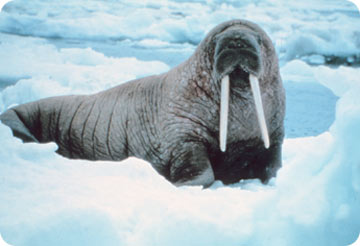For the Pacific walrus, the summer hotspot is the fertile waters of the Chukchi Sea, which spans the gap between the northern coasts of Alaska and Siberia. It offers a mild climate and an almost endless buffet of clams.
 The Chukchi Sea is the summer hotspot for the Pacific walrus. Credit: National Oceanic and Atmospheric Administration
The Chukchi Sea is the summer hotspot for the Pacific walrus. Credit: National Oceanic and Atmospheric AdministrationOver the last few years, though, the accommodations have lost some of their appeal. The sea ice that serves as resting places and fishing platforms has thinned out -- sometimes disappearing completely.
A walrus typically feeds for days at a time, diving to the shallow ocean floor over and over again to dig up food. After a while, though, the walrus needs to surface to breathe. Drifting sea ice offers a perfect place to rest. It also provides a safe haven for mothers who are looking after their pups, and it even carries the animals to new feeding grounds.
But a warming climate has melted most or all of the summer ice in the Chukchi, so the walruses have congregated on shore. That puts them farther from the best food sources, so hunting requires more energy. What’s more, the walruses are easily spooked. When they’re disturbed, they plunge toward the water, sometimes creating stampedes in which hundreds of animals are crushed.
Today, native peoples are allowed to kill a few thousand walruses a year for food, but otherwise the creatures are protected by laws and treaties. That’s allowed the number of Pacific walruses to climb to perhaps 200,000. But scientists say their future looks a bit uncertain. Like the ice that supports them, much of the walrus population could melt away.

